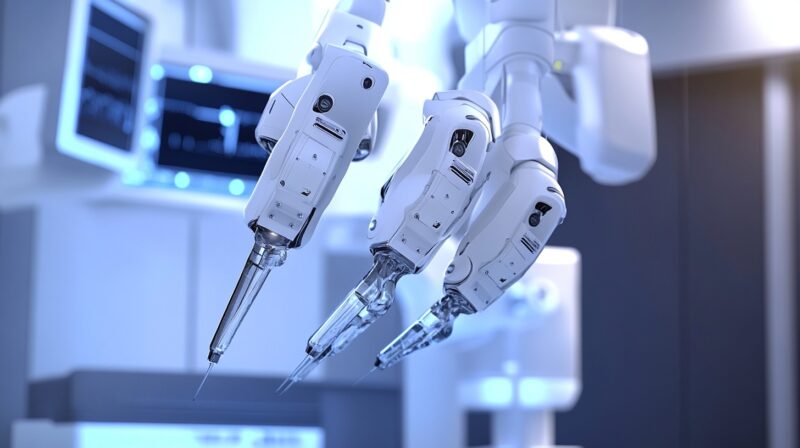Minimally invasive surgeries have revolutionized modern medicine, offering patients faster recovery times, less pain, and smaller scars compared to traditional open surgery.
With technological advancements, selecting the most appropriate surgical technique is vital for optimizing patient outcomes.
Two of the most widely used minimally invasive approaches are laparoscopic and robotic surgery.
Both offer unique benefits, but their differences can significantly impact the patient’s experience and the surgeon’s performance.
Overview of Laparoscopic Procedure
Laparoscopic surgery, also known as keyhole surgery, has been a cornerstone in minimally invasive procedures since its development in the 1980s.
It involves making small incisions, through which a camera and surgical tools are inserted to carry out the operation.
The camera provides a two-dimensional view of the surgical site, which the surgeon uses to guide the instruments. The surgeon performs the procedure manually, controlling the instruments directly while watching the monitor.
Commonly, laparoscopic surgery is employed for procedures such as gallbladder removal, hernia repair, and appendectomies.
One of its primary advantages is the minimal trauma to the body, leading to:
- Less postoperative pain
- Quicker recovery
- Smaller scars compared to traditional surgery
Patients undergoing laparoscopic surgery typically experience reduced blood loss and fewer complications.
Overview of Robotic Procedure
Robotic-assisted surgery has emerged as a more advanced form of minimally invasive surgery, providing enhanced precision and control for surgeons.
In robotic surgery, the surgeon does not directly handle the instruments but instead operates them via a console.
This console offers a three-dimensional, high-definition view of the surgical site, providing depth perception that greatly enhances accuracy.
One of the key features is the use of arms that mimic the movements of the surgeon’s hands but with greater precision and flexibility.
Procedures like prostate surgery, hysterectomies, and certain heart surgeries are often performed using complex systems.
Benefits of Robotic Over Laparoscopic Surgery
Now let us talk about the benefits robotic surgery has over laparoscopic surgery.

Enhanced Precision and Control
Robotic surgery offers significant advantages in terms of precision and control, making it the preferred option for procedures that demand high accuracy.
One of the standout benefits is the elimination of hand tremors, as the robotic system provides steady and controlled movements.
Three-Dimensional Imaging for Better Visualization
Unlike the two-dimensional view offered in laparoscopic surgery, robotic systems provide a three-dimensional, high-definition view of the surgical site.
This enhanced visualization allows surgeons to see more clearly, improving depth perception and enabling better decision-making during complex procedures.
Increased Range of Motion
Robotic arms offer a greater range of motion compared to traditional laparoscopic instruments.
The flexibility of these arms allows surgeons to perform more intricate movements that would otherwise be difficult or impossible using conventional tools.
Improved Patient Outcomes
Robotic surgery often results in better outcomes for patients. The precision of the system can minimize tissue damage, which leads to fewer postoperative complications, reduced pain, and faster recovery times.
By causing less trauma to the body, robotic surgery allows patients to heal more quickly and with less discomfort, offering a superior recovery experience compared to laparoscopic surgery in many cases.
What are the Limitations?

While robotic surgery presents several advantages, there are notable limitations that must be considered.
High Costs
One of the most significant drawbacks is the cost associated with the technology. Robotic systems are expensive to purchase, maintain, and operate.
These costs often get passed on to patients and healthcare systems, which can make procedures less affordable.
Limited Accessibility
Due to the high expenses, robotic procedures are often less accessible, particularly in smaller hospitals or in regions with limited healthcare infrastructure.
Many facilities may not have the financial means to invest in the necessary systems, which restricts patient access.
Suitability for Certain Procedures
Robotic surgery may not be the best option for all procedures. For more routine surgeries like hernia repairs or appendectomies, laparoscopic procedures can be just as effective while being more cost-efficient.
Robotic systems are generally reserved for more complex procedures where enhanced precision is required.
Surgeon Expertise and Training Requirements
The complexity of operating robotic systems means that surgeons require specialized training to use them effectively. Surgeons who are less experienced with robotic techniques might opt for laparoscopic surgery, which can be a safer alternative in such cases.
Availability of Robotic Equipment
Not all hospitals have access to the necessary robotic equipment, particularly in less developed or remote areas. The limitation can reduce patient choice and make robotic surgery an option only for those in well-funded medical facilities.
Which Is Better? – Factors to Consider

Deciding between laparoscopic and robotic surgery involves weighing several factors, including:
- Patient’s Health Condition: The patient’s overall health and specific condition can influence which surgical method is most appropriate. Simpler procedures, such as gallbladder removal or hernia repair, may be sufficiently handled with laparoscopic procedures, while more complex cases may benefit from robotic precision.
- Complexity of the Surgery: For surgeries requiring high precision or involving tight spaces, robotic procedures may provide better outcomes due to its enhanced control and dexterity.
- Surgeon Expertise: The experience and comfort level of the surgeon with either laparoscopic or robotic techniques play a crucial role. If a surgeon is more proficient with one method, it might be safer and more effective to use that technique.
- Availability of Robotic Systems: Hospitals may not always have access to robotic technology, particularly in smaller or less-resourced facilities. In such cases, laparoscopic surgery may be the default option due to its wider availability.
- Cost Considerations: Robotic procedures are generally more expensive due to the cost of the equipment. Not all insurance plans cover robotic procedures, making laparoscopic surgery the more affordable choice for many patients.
Ultimately, the decision should be made after carefully evaluating the patient’s specific needs, the surgeon’s expertise, the complexity of the procedure, and the costs involved.
Related Posts:
- Do Fancy Degrees Really Make Better Healthcare Workers?
- How to Use Natural Sleep Aids for Better Rest
- Outpatient Surgery vs. Inpatient Care: Which Is…
- Nurse Practitioner vs Physician Assistant: Which…
- How Much Does Medicare Pay For Outpatient Surgery:…
- How Much Does Aflac Pay for Outpatient Surgery: Find Out!















